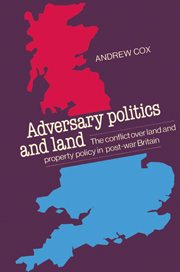Book contents
- Frontmatter
- Contents
- Preface
- PART A INTRODUCTION
- PART B THE PROBLEM OF LAND AND PROPERTY IN BRITAIN AND THE EFFECTIVE LIMITS ON GOVERNMENT POLICY INITIATION
- 2 The history of land and property policy in Britain and the development of social democratic solutions (1845–1945)
- 3 The structure of the British land and property market as constraint on policy initiation
- PART C THE HISTORY OF ADVERSARIAL POLICY FAILURE IN LAND AND PROPERTY IN POST-WAR BRITAIN
- PART D CONCLUSION
- Notes
- Index
3 - The structure of the British land and property market as constraint on policy initiation
Published online by Cambridge University Press: 29 September 2009
- Frontmatter
- Contents
- Preface
- PART A INTRODUCTION
- PART B THE PROBLEM OF LAND AND PROPERTY IN BRITAIN AND THE EFFECTIVE LIMITS ON GOVERNMENT POLICY INITIATION
- 2 The history of land and property policy in Britain and the development of social democratic solutions (1845–1945)
- 3 The structure of the British land and property market as constraint on policy initiation
- PART C THE HISTORY OF ADVERSARIAL POLICY FAILURE IN LAND AND PROPERTY IN POST-WAR BRITAIN
- PART D CONCLUSION
- Notes
- Index
Summary
The structure of the British land and property market. Potential land values policies. The policy constraints imposed by the structure, nature and development of the British land and property market. Realistic long-term policy possibilities in the British land and property market.
It was observed in Chapter I that there is a conceptual distinction to be drawn between the power to initiate policy in the political decisionmaking process and the power to constrain and resist the successful implementation of policy. The discussion in the last chapter was almost wholly confined to the analysis of the first of these dimensions of power. During the wartime conflict over the Barlow and Uthwatt proposals interventionist inclined policy-makers could not overcome opposition from local authority, landowning, development and building interests because these were able to influence Conservative politicians and senior civil servants, in the Treasury and Ministry of Health. But it can be argued that these interests also have a further ‘power’ outside the political system.
This power relates to the ability to deny the successful implementation of policy which has been initiated in government. It was impossible to reveal this in the discussion of the fate of the Barlow and Uthwatt proposals because the radical elements of these Reports did not shape policy. The remainder of this study, however, does provide the opportunity to indicate the power of constraint over policy implementation because, since the Second World War, there has been a history of adversarial land values policy-making in Britain. Both types of policy, aimed either at land nationalisation or a return to free market (laissezfaire) conditions, have failed in implementation.
- Type
- Chapter
- Information
- Adversary Politics and LandThe Conflict Over Land and Property Policy in Post-War Britain, pp. 51 - 74Publisher: Cambridge University PressPrint publication year: 1984



